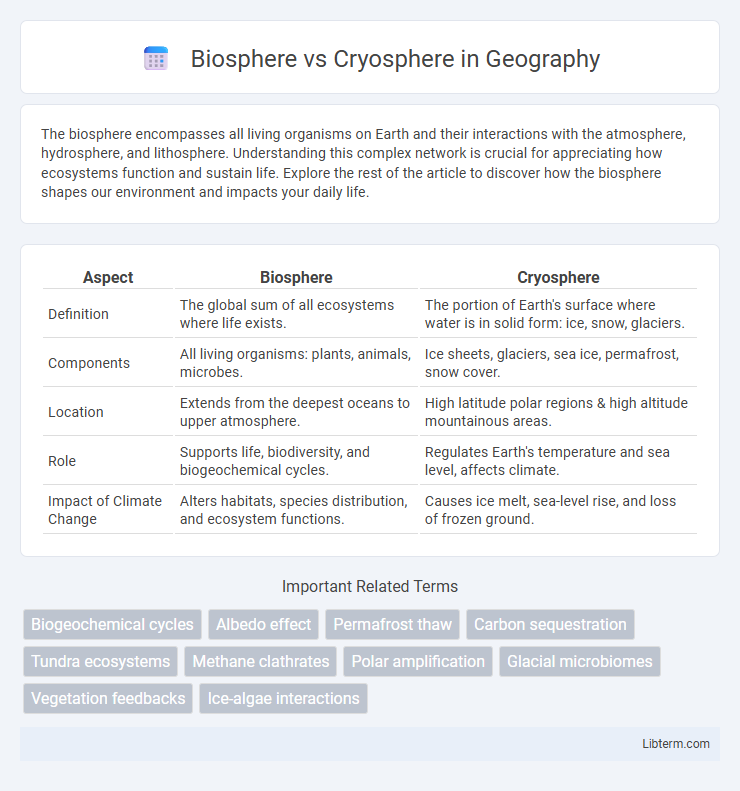The biosphere encompasses all living organisms on Earth and their interactions with the atmosphere, hydrosphere, and lithosphere. Understanding this complex network is crucial for appreciating how ecosystems function and sustain life. Explore the rest of the article to discover how the biosphere shapes our environment and impacts your daily life.
Table of Comparison
| Aspect | Biosphere | Cryosphere |
|---|---|---|
| Definition | The global sum of all ecosystems where life exists. | The portion of Earth's surface where water is in solid form: ice, snow, glaciers. |
| Components | All living organisms: plants, animals, microbes. | Ice sheets, glaciers, sea ice, permafrost, snow cover. |
| Location | Extends from the deepest oceans to upper atmosphere. | High latitude polar regions & high altitude mountainous areas. |
| Role | Supports life, biodiversity, and biogeochemical cycles. | Regulates Earth's temperature and sea level, affects climate. |
| Impact of Climate Change | Alters habitats, species distribution, and ecosystem functions. | Causes ice melt, sea-level rise, and loss of frozen ground. |
Introduction to the Biosphere and Cryosphere
The biosphere encompasses all living organisms on Earth and their interactions within ecosystems, including terrestrial, marine, and freshwater environments. The cryosphere comprises all the frozen water parts of the Earth system, such as glaciers, ice caps, sea ice, permafrost, and snow cover, playing a crucial role in regulating global climate and sea levels. Both spheres interact dynamically, influencing Earth's energy balance and supporting life processes.
Defining the Biosphere
The biosphere encompasses all living organisms on Earth, including plants, animals, fungi, and microorganisms, interacting with the atmosphere, hydrosphere, and lithosphere. It plays a crucial role in sustaining life by regulating global biogeochemical cycles such as carbon and nitrogen cycles. Unlike the cryosphere, which consists of Earth's frozen water regions like glaciers and ice caps, the biosphere is defined by the presence and dynamics of life.
Understanding the Cryosphere
The cryosphere encompasses all frozen water parts of the Earth system, including glaciers, snow cover, sea ice, and permafrost, playing a critical role in regulating global climate and sea levels. Understanding the cryosphere involves monitoring its seasonal and long-term changes, which directly impact ocean circulation, weather patterns, and carbon cycles. Research on cryospheric dynamics helps predict consequences of global warming, such as ice sheet melting and permafrost thawing, essential for climate modeling and environmental policy decisions.
Key Differences Between Biosphere and Cryosphere
The biosphere encompasses all living organisms and their interactions within Earth's ecosystems, while the cryosphere includes all frozen water parts such as glaciers, ice caps, and permafrost. The biosphere is characterized by biological diversity and life processes, whereas the cryosphere significantly influences global climate through ice-albedo feedback and sea level regulation. Unlike the biosphere, which thrives on energy flow and nutrient cycles, the cryosphere primarily affects physical Earth systems through its temperature and state changes.
Interactions Between Biosphere and Cryosphere
The interactions between the biosphere and cryosphere significantly influence Earth's climate system, where melting ice affects habitats and species distribution within the biosphere. Seasonal snow cover and glaciers regulate freshwater availability, impacting terrestrial and aquatic ecosystems. Changes in cryospheric elements alter carbon storage and nutrient cycling in the biosphere, affecting global ecological balance.
Impact of Climate Change on Both Spheres
Climate change accelerates the melting of the cryosphere, including glaciers and polar ice caps, leading to rising sea levels and loss of habitat for cold-adapted species. The biosphere experiences shifts in ecosystems, altered species distributions, and increased frequency of extreme weather events caused by temperature and precipitation changes. Both spheres are interconnected, as cryosphere decline influences biosphere processes through changes in freshwater availability and global climate regulation.
Role in Global Carbon and Water Cycles
The biosphere plays a crucial role in the global carbon cycle through photosynthesis, where plants absorb atmospheric CO2 and store it as biomass, and through respiration, which releases CO2 back into the atmosphere. The cryosphere influences the water cycle by regulating freshwater storage in glaciers, ice sheets, and snowpacks, which control seasonal water flow and sea level rise. Together, the biosphere and cryosphere modulate Earth's climate by balancing carbon sequestration and freshwater distribution essential for sustaining ecosystems and global climate stability.
Biodiversity in the Biosphere vs. Cryosphere
The biosphere supports vast biodiversity, hosting millions of species adapted to diverse ecosystems including forests, grasslands, and oceans, which collectively sustain complex food webs and genetic diversity. In contrast, the cryosphere, encompassing polar ice caps, glaciers, and permafrost regions, has limited biodiversity primarily consisting of specially adapted microorganisms, cold-tolerant plants, and animals like polar bears and penguins. The biosphere's rich biodiversity drives ecological balance and resilience, whereas the cryosphere's limited species serve as indicators of climate change impacts on fragile Arctic and Antarctic environments.
Human Influence on Biosphere and Cryosphere
Human activities significantly impact the biosphere through deforestation, urbanization, and pollution, leading to habitat loss and biodiversity decline. In the cryosphere, anthropogenic climate change causes accelerated melting of glaciers, ice sheets, and permafrost, contributing to sea level rise and altered global climate patterns. These transformations disrupt ecological balance and increase the vulnerability of both systems to further environmental stress.
Future Outlook for Both Spheres
The future outlook for the Biosphere involves increasing challenges due to habitat loss, climate change, and biodiversity decline, necessitating urgent conservation efforts and sustainable management. The Cryosphere faces rapid transformations with accelerated ice melt, permafrost thawing, and rising sea levels, significantly impacting global climate systems and weather patterns. Effective mitigation and adaptation strategies are critical to preserving the integrity of both spheres amidst ongoing environmental changes.
Biosphere Infographic

 libterm.com
libterm.com